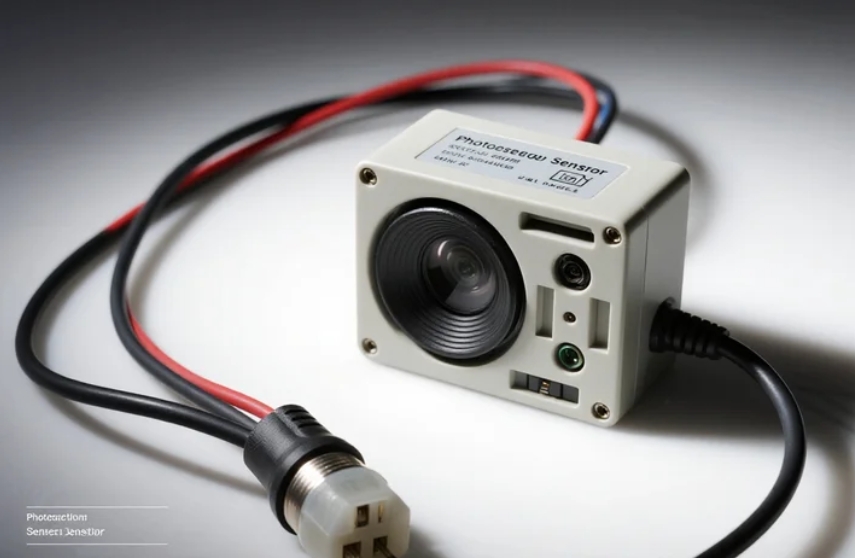How Photoelectric Detectors Power Our Invisible World
Ever wonder how your smartphone automatically adjusts brightness, factory machines “see” products flying by, or security systems know someone’s approaching? The unsung hero behind these feats is the photoelectric detector – a device turning light into actionable intelligence.
So, What Exactly Does a Photoelectric Detector Do?
At its core, a photoelectric detector is a device that converts light signals (photons) into electrical signals (current or voltage) . Think of it as a tiny translator, sensing changes in light – whether the beam is blocked, reflected, or its intensity shifts – and instantly turning that information into an electrical output that machines, computers, or control systems can understand and act upon . This fundamental ability, primarily based on the photoelectric effect (where light hitting certain materials knocks electrons loose) , makes them incredibly versatile “eyes” for countless applications.
How Do These “Light Sensors” Actually Work?
Most photoelectric detectors have three key parts :
- The Light Source (Emitter): Typically an LED (visible red, green, or infrared) or a laser diode, sending out a focused beam of light.
- The Receiver: Usually a photodiode or phototransistor, meticulously designed to detect the emitted light and convert its presence, absence, or change in intensity into an electrical current .
- The Detection Circuit: The brains that process the receiver’s signal, filtering out noise and triggering a clean, reliable output (like turning a switch on/off or sending a data signal).
They detect objects or changes using different “sighting” methods:
- Through-Beam (Transmission): Emitter and receiver face each other. An object is detected when it blocks the light beam. Offers the longest range (10+ meters) and highest reliability .
- Retroreflective: Emitter and receiver are in the same unit, facing a special reflector. An object is detected when it breaks the reflected beam. Easier alignment than through-beam but can be fooled by very shiny objects .
- Diffuse Reflective: Emitter and receiver are in the same unit, pointing towards the target. The object is detected when it reflects the emitted light back to the receiver. Doesn’t need a separate reflector, but detection depends on the object’s surface .
- Background Suppression (BGS): A smarter diffuse type. Using triangulation, it only detects objects within a specific, preset distance range, ignoring anything beyond it or too close behind the target .
Why Are They Everywhere? Key Advantages:
Photoelectric detectors dominate many sensing tasks because they offer unique benefits :
- Non-Contact Sensing: They don’t need to touch the object, preventing wear and tear on both the sensor and delicate items.
- Long Detection Ranges: Especially through-beam types, far exceeding inductive or capacitive sensors.
- Lightning-Fast Response: Electronic components react in microseconds, perfect for high-speed production lines.
- Material Agnostic: Detect virtually anything – metal, plastic, glass, wood, liquid, cardboard – unlike inductive sensors that only sense metal.
- Small Object Detection & High Resolution: Can sense tiny parts or precise positions.
- Color and Contrast Discrimination: Can differentiate objects based on how they reflect or absorb specific light wavelengths.
Where You’ll Find Them in Action (Real-World Impact):
The applications are vast and touch nearly every industry:
- Industrial Automation (The Powerhouse): Counting products on conveyors , verifying bottle caps are on , detecting labels , positioning robotic arms, ensuring packaging is filled, monitoring assembly lines . They are fundamental to modern manufacturing efficiency.
- Security & Access Control: Automatic door sensors , intrusion detection beams, people counting systems.
- Consumer Electronics: Smartphone ambient light sensors, TV remote control receivers, optical mice.
- Automotive: Rain sensors for automatic wipers, obstacle detection in safety systems, headlight control .
- Healthcare: Critical components in smoke detectors analyzing air samples , pulse oximeters measuring blood oxygen , medical imaging equipment like advanced CT scanners .
- Communications: Fiber optic networks rely on photodetectors to convert light pulses back into electrical data signals .
- Energy: Solar cells (a type of photovoltaic detector) converting sunlight into electricity .
The Future is Bright: What’s Next?
Photoelectric detector technology isn’t standing still. Cutting-edge advancements are pushing boundaries :
- Extreme Miniaturization: Development of tiny, color-sensitive detectors using nanomaterials like hybrid nanofibers and silicon nanowires.
- Enhanced Performance: 2D/3D heterostructure materials (like MoS2/GaAs, Graphene/Si) enabling ultra-high-speed, ultra-sensitive detectors, even for challenging UV light.
- Smarter Functionality: Detectors with built-in spectral analysis (hyperspectral imaging) or polarization sensitivity for richer information capture.
- Broader Applications: Enabling new possibilities in medical diagnostics, environmental monitoring, quantum computing, and next-generation displays.
Market Boom: Reflecting the Demand
The explosive growth in automation and smart technologies is directly fueling the photoelectric detector market. Valued at USD 1.69 Billion in 2022, it’s projected to surge to a staggering USD 4.47 Billion by 2032, growing at a robust 10.2% CAGR . The Asia-Pacific region, driven by massive manufacturing automation and electronics production, is leading this charge . Major players like Hamamatsu, OSRAM, and LiteON are continuously innovating to meet this soaring demand .
Post time: Jul-11-2025





